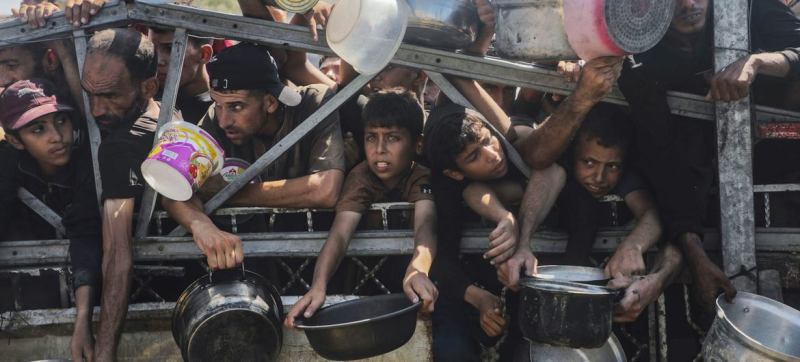- US May Ease Tariffs Further as Trade Gap Narrows |
- Arab-Islamic summit over Israeli strike on Doha Monday |
- NASA Rover Uncovers Strongest Hint of Ancient Life on Mars |
- Eminent Lalon singer Farida Parveen passes away |
- Dr Yunus mourns Farida Parveen's death |
Gaza Aid Insufficient as Starvation and Displacement Worsen

Children trying to get food from aid distribution centers in Gaza.
The small trickle of aid entering Gaza is entirely insufficient to alleviate starvation and displacement in the Strip, UN humanitarians said on Tuesday.
“The risk of starvation is everywhere in Gaza,” UN Human Rights Office spokesperson Thameen Al-Kheetan told reporters in Geneva.
“This is a direct result of the Israeli government's policy of blocking humanitarian aid,” he said.
Mr. Al-Kheetan insisted that in the past few weeks, Israeli authorities have only allowed aid to enter in quantities “far below what would be required to avert widespread starvation.”
The UN said on Monday that hunger-related deaths continue to be reported in the Strip, including among children.
As the Israeli army intensified its attacks in the north of the enclave, it has continued to issue displacement orders for Palestinians, Mr. Al-Kheetan said.
He noted that Gazans have been told to move to the Al-Mawasi area, despite ongoing airstrikes and disastrous conditions there.
“Hundreds of thousands of Palestinians displaced to Al-Mawasi have little or no access to essential services and supplies, including food, water, electricity, and tents,” he warned.
The OHCHR spokesperson stressed that reaching humanitarian aid “can be a deadly pursuit,” with the latest data indicating that 1,857 Palestinians were killed while seeking food from 27 May, when the US and Israel-backed Gaza Humanitarian Foundation began its operations.
Of that number, 1,021 were killed near Gaza Humanitarian Foundation sites and 836 on supply truck routes.
“Most of these killings appear to have been committed by the Israeli military,” Mr. Al-Kheetan said.
Asked how the situation could worsen further, Jens Laerke, spokesperson for the UN Office for the Coordination of Humanitarian Affairs (OCHA), said that “it has already gotten worse,” citing the devastating effects of the Israeli ban on shelter materials.
While Israeli authorities recently announced that they would lift the ban on shelter supplies, Mr. Laerke said that “the United Nations and our partners, as of last night, have not been able to bring in shelter materials following the Israeli announcement.”
“There’s a set of impediments that still needs to be addressed, including Israeli customs clearance,” he added.
The UN said on Monday that, according to partner estimates, at least 1.35 million people in Gaza need emergency shelter.
Aid agencies have warned that tents being used in Gaza are worn out due to prolonged sun exposure and repeated displacement.
Asked about the reasons given for the ban on shelter items, Mr. Laerke explained that in conflict situations, some shelter items, such as tent poles, fall under the “dual-use regime,” as they could be used for both civilian and military purposes.
“Shelter has been banned entry for about five months, during which over 700,000 people have been displaced or re-displaced,” he said.
People forced to flee repeatedly often have to leave behind the tents they were provided, Mr. Laerke explained, creating a challenge for aid workers “trying to respond to people where they are.”
The looming expansion of Israel’s military activities in Gaza City is another major concern for UN humanitarians, as it would again push thousands into a severely overcrowded area in the south of the Strip.
Asked about the impact of Israel’s plans to occupy Gaza City, OHCHR’s Mr. Al-Kheetan emphasized the “huge risk” for civilians.
“There are risks of mass displacement… more killings, and more misery than we have already seen in the Gaza Strip,” he warned. “Among those affected are the most vulnerable: people with disabilities, the injured, children, and women,” he concluded.

